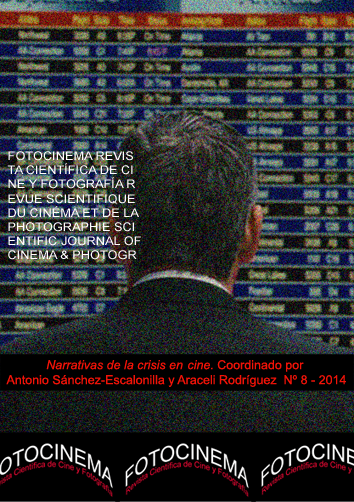La política audiovisual. Crítica y estrategia en la producción y distribución de los documentales del 15M
DOI:
https://doi.org/10.24310/Fotocinema.2014.v0i8.5952Resumen
Tras las crisis sociales acaecidas en los últimos años aparece un nuevo movimiento social posicionado críticamente contra las corporaciones económicas y contra la clase política: el 15M. Sus reivindicaciones giran en torno a una mayor participación de la ciudadanía en los asuntos públicos y sus formas de organización adoptan una estructura no jerarquizada, horizontal, abierta y colectiva. El objetivo de este artículo es valorar las coherencias e incoherencias que se dan entre esta forma de democracia participativa y las formas de los documentales producidos sobre el movimiento hasta la fecha. Para ello, analizaremos las formas de producción y de distribución de estos documentos audiovisuales desde dos perspectivas: una crítica contra las formas de algunos documentales que conservan todavía los recursos visuales y estructuras del aparato ideológico contra el que combaten; y otra estratégica que aporte ideas sobre los dispositivos estéticos y narrativos que deberían de tener estos productos audiovisuales para ser coherentes con los dispositivos políticos del movimiento 15M.
Palabras clave:
Documentales del 15M; Producción audiovisual; Distribución audiovisual; Enunciación colectiva; Representación múltiple; Narración abierta
Keywords:
Documentary 15M; Audiovisual production; Audiovisual distribution; Collective enunciation; Multiple representation; Open NarrationDescargas
Métricas
Publicación Facts
Perfil de revisores N/D
Información adicional autores
Indexado: {$indexList}
-
Indexado en
- Sociedad Académica/Grupo
- N/D
- Editora:
- Universidad de Málaga
Descargas
Publicado
Cómo citar
Número
Sección
Licencia
Todos los contenidos publicados en Fotocinema. Revista científica de cine y fotografía están sujetos a la licencia Creative Commons Reconocimento-NoComercia-Compartirigual 4.0 cuyo texto completo puede consultar en <http://creativecommons.org/licenses/by-nc-sa/4.0>
Se pueden copiar, usar, difundir, transmitir y exponer públicamente, siempre que:
- Se cite la autoría y la fuente original de su publicación (revista, editorial y URL de la obra).
- No se usen para fines comerciales.
- Se mencione la existencia y especificaciones de esta licencia de uso.
Los derechos de autor son de dos clases: morales y patrimoniales. Los derechos morales son prerrogativas perpetuas, irrenunciables, intransferibles, inalienables, inembargables e imprescriptibles. De acuerdo con la legislación de derechos de autor, Fotocinema. Revista científica de cine y fotografía reconoce y respeta el derecho moral de los autores/as, así como la titularidad del derecho patrimonial, el cual será cedido a la Universidad de Málaga para su difusión en acceso abierto. Los derechos patrimoniales, se refieren a los beneficios que se obtienen por el uso o divulgación de las obras. Fotocinema. Revista científica de cine y fotografía se publica en open access y queda autorizada en exclusiva para realizar u autorizar por cualquier medio el uso, distribución, divulgación, reproducción, adaptación, traducción o transformación de la obra.
Es responsabilidad de los autores/as obtener los permisos necesarios de las imágenes que están sujetas a derechos de autor.















13.png)



